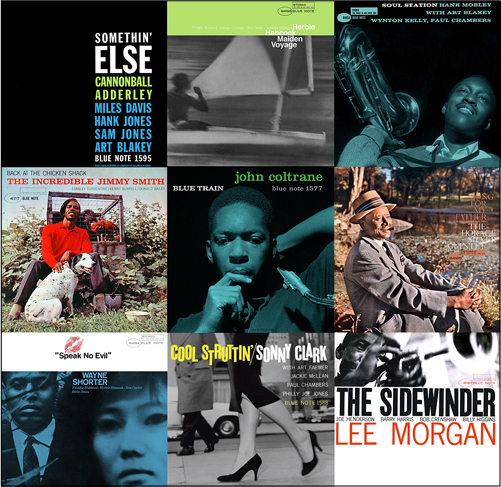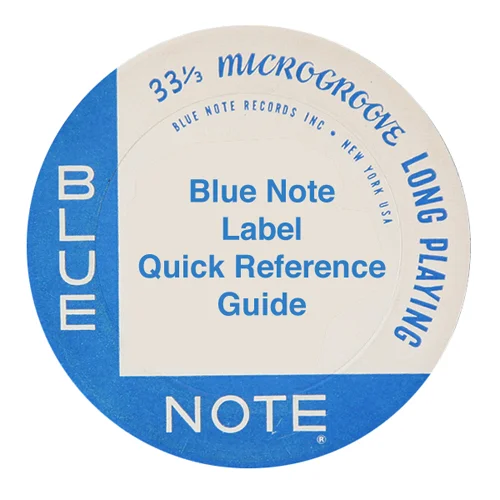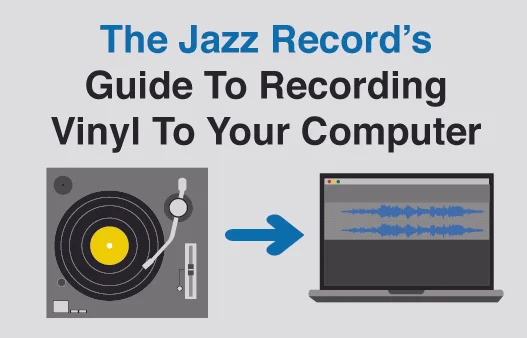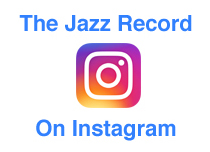Blue Note Records: The Ten Essential Albums
/The following ten albums represent the very best of what made Blue Note the premier jazz label during the golden age of jazz music (a period running roughly 1956 to 1968). They showcase the finest jazz music and artists that emerged during a time when jazz music was at it's commercial and creative peak. As with any list that attempts to compress a label and genre into a neat package there are some extremely important artists, albums and styles that didn't make the cut, but that only goes to show just how diverse and expansive Blue Note was during this time.
The following albums are available in any number of different formats, and while it's no surprise that I will tell you that they are best enjoyed on vinyl (be it vintage or newer pressings), that should by no means keep you from acquiring them and adding them to your collection in whatever manner you choose. These ten albums make up the core of any Blue Note collection and belong in any and every self-respecting music library.
The following albums are listed by year of release, because it would be a meaningless endeavor to attempt to rank them in any sort of order of greatness.
Cannonball Adderley - Somethin' Else - Released 1958
When Cannonball Adderley hit the studio in March of 1958 he was a member of the Miles Davis Sextet (the one that would record Kind Of Blue), so why not bring along his boss to play with him on the album that would become Somethin' Else. It was a very rare appearance by Miles as a sideman at this point in his career, but an important one: it resulted in one of the finest hard bop albums ever made. The group's take on the nearly eleven minute opening track "Autumn Leaves" threatens to overshadow the rest of the album with it's mind blowing moody intensity and slow burning solos, and yet it serves as the perfect opener for the rest of the record. The album never lets up, whether it be the upbeat Miles composed title track or the beyond bluesy "One For Daddy-O," making Somethin' Else an album that has it all for any stripe of jazz or Blue Note fan. This was one of the first Blue Note albums I ever heard, and even after hundreds of listens it remains one of my very favorite jazz LPs to this very day.
Art Blakey and The Jazz Messengers - Moanin' - Released 1958
This album would be required listening for the title track alone, as it is hands down one of the best hard bop tracks ever recorded. One track does not make a classic album, however, and Moanin' is definitely no one-trick pony. "Along Came Betty" and "Blues March" are both tunes that, along with the title track, have rightfully become jazz standards. Another reason Moanin' needs to be any jazz collection is the group that Blakey assembled for this version of the Jazz Messengers. Both Benny Golson on tenor and Bobby Timmons on piano are unsung heroes of the hard bop era, and in addition to their fantastic playing on the album they get to show off their underrated compositional skills as well (Timmons composed the title track, while Golson contributed "Along Came Betty" and "Blues March"). Add on to that the smokin' hot playing of a young Lee Morgan on trumpet, Jymie Merritt on bass and the unparalleled skill of Blakey on the skins, and all the pieces were in place for Blakey to make the album that rightfully defined his career.
Sonny Clark - Cool Struttin' - Released 1958
While Sonny Clark is highly regarded by longtime Blue Note fans, he is not particularly well known in the greater jazz world, which is a shame because he was a huge talent, and Cool Struttin' was his masterpiece. Considered by some to be the epitome of the early Blue Note hard bop sound, it has so many things going for it that it's hard to know where to start. First off, you have Clark on the piano at the peak of his powers, laying down his complex yet soulful riffs. Next, you have two Blue Note legends in Jackie Mclean and Paul Chambers playing alongside him. Then there is the presence of the criminally under-appreciated Art Farmer on trumpet, making a rare appearance on a Blue Note session. Finally, the stunning cover art ranks as one of Reid Miles finest for the label. Of course, and most importantly, there is the music: soulful, bluesy hardbop played by some master musicians all at the top of their game, making for a must own gem of an album that rewards repeated listening.
John Coltrane - Blue Train - Released 1958
John Coltrane is one of the undisputed masters of jazz music, and while his later recordings for the Atlantic and Impulse! labels are rightfully revered by jazz fans, Trane also made some amazing albums early in his career when he was developing his legendary chops on the tenor saxophone. Blue Train would be his only recording for Blue Note as a leader, and for that reason alone it could gain classic status, but it also happens to be one of the all-time great hard bop sessions ever laid down for the label. Trane's playing is straight-ahead (no free jazz flourishes here), but he was coming into his own and his solos are full of invention and energy. I think the secret weapon on Blue Train is the great Curtis Fuller on trombone, who adds a lushness and texture to the tracks that is simple yet extraordinary. A young Lee Morgan on trumpet rounds out the triple horn frontline and is outstanding throughout, as is Kenny Drew on the piano. Anchoring the sextet is the rock solid rhythm section of Paul Chambers and Philly Joe Jones, making for a classic Blue Note lineup behind Trane on one of his early masterpieces.
Hank Mobley - Soul Station - Released 1960
It's hard to believe there was a time not so long ago that Hank Mobley's contributions to the Blue Note label were mostly an afterthought. That has been remedied with a much deserved rediscovery and appreciation of his timeless music over the last couple of decades. No single recording better captures the essence of Mobley's hard bop talent on the tenor and as a composer than Soul Station, his finest work in a catalog filled with classic albums. The record is a lesson in musical efficiency: most of Mobley's catalog finds him teaming up with at least one other horn player, but on Soul Station he goes it alone, and every melody and solo is near perfection with no notes wasted or meaningless flourishes to muddy up the proceedings. The quartet is made up of consummate hard bop players, with Wynton Kelly on the piano (whose rapport with Mobley on this session is otherworldly) and Paul Chambers and Art Blakey manning the rhythm section. Everyone is in absolute peak form as they run through three Mobley originals and two standards. The tunes are soulful, bluesy and pure jazz bliss. Soul Station shows us one of Blue Note's most vital artists at the peak of his powers, and it's beauty and artistry grows every time you hear it.
Jimmy Smith - Back At The Chicken Shack - Released 1963
Jimmy Smith was not only of the most popular artists on the Blue Note roster, he was also one of the most profilic, recording nearly forty sessions for the label over an eight year period starting in 1956. With his great skill on the Hammond B-3 organ he became a pioneering force behind the soul jazz movement, which took the hard bop sound and added funky elements from the blues, soul, gospel and rhythm and blues. Smith laid down the blueprint for artistic soul jazz music, whether it be on his many trio albums or when he brought in a horn player as he did on his classic Back At The Chicken Shack. The album finds him working again with Kenny Burrell on guitar and Donald Bailey on drums (as he often did) and bringing along a young Stanley Turrentine on the tenor into to bring his sound to new heights. The music is definitely catchy and infectious (which is why it was jazz's most popular style throughout the 1960s), but in the hand's of Smith and his quartet it is also creative and complex with inventive solos by all involved. During his time at Blue Note Smith proved once and for all that in the right hands the Hammond B-3 was a true jazz instrument, and with Back At The Chicken Shack he set the bar quite high for all future organ-combo soul jazz sessions.
Lee Morgan - The Sidewinder - Released 1964
Lee Morgan was a giant talent on the trumpet and his musical legacy and enduring success are forever tied to the Blue Note label. He spent nearly his entire career recording for Blue Note (he would die tragically young in 1972 at the age of 33), and every album he released on the label is worthy of a place in any jazz collection. The Sidewinder is the undeniable peak of his discography: it's not only a stone-cold classic album, but it's one of a handful of albums that defines the very essence of Blue Note and what has kept the label's output so popular over the years. The title track was an unexpected crossover hit on the pop and R&B charts in 1964 - a feat the label and it's artists tried (and mostly failed) to replicate with it's catchy refrain and joyful soulfulness. The group assembled for The Sidewinder had a lot to do with its success: Joe Henderson on the tenor was an important member of the Blue Note roster of artists both as a leader and sideman, and Billy Higgins once again proves why he is known as the greatest of hard bop drummers. Joining Higgins in the rhythm section were Barry Harris on the keys and Bob Crenshaw on the bass, both of whom played an equally important part in the album's sound and success. Then there is Morgan on his horn, at the top of his game, playing glorious and inventive solos that remain hugely influential today. Despite the wide commercial success it had outside of the jazz community The Sidewinder has remained a classic and a favorite among jazz fans, not for it's catchiness or popular acclaim, but because at the end of the day it is an adventurous and intelligent hard bop record that hasn't lost any of it's vitality since the day it was released
Herbie Hancock - Maiden Voyage - Released 1965
While Herbie Hancock may be a household musical name these days, there was a time when he was just another jazz musician with tons of talent trying to create a legacy for himself. By 1965 Hancock had released four excellent albums on Blue Note, and was also a member of Miles Davis' second great quintet, a group that was setting the pace with it's exciting new style of hard bop. It only made sense for Hancock to bring along Ron Carter and Tony Williams, his fellow rhythm section members from the Davis group, when he hit the studio to record Maiden Voyage, the album that would become his first true masterpiece. The rapport and familiarity between Hancock, Carter and Williams is thrilling, allowing for an openness and fluidity that would otherwise have been difficult to achieve. Rounding out the group are Freddie Hubbard on trumpet and George Coleman on tenor saxophone, both of whom simply slay it on the five Hancock originals that make up the original LP. Maiden Voyage represents everything that made Blue Note so legendary and a monument to it's enduring legacy: the tunes are complex and forward-looking, but are completely accessible to the casual jazz fan. Hancock may have made more adventurous (and groundbreaking) albums, but he never made a better straight-ahead jazz statement than he did with Maiden Voyage.
Horace Silver - Song For My Father - Released 1965
Song For My Father has to be included on any essential Blue Note album list because (1) it is a stone cold classic and (2) it is the high point of one of Blue Note's most vital artists and the hard bop sound he helped popularize at the label. Silver was nothing less than a master at combining infectious melody lines with complex rhythms and arrangements, and the title track on Song For My Father may be the pinnacle of that sound. The LP was actually born out of two seperate recording sessions; two of the tracks (Calcutta Cutie and the trio track Lonely Woman) were recorded with the most acclaimed version of Silver's quintet with Blue Mitchell (tp), Junior Cook (ts), Gene Taylor (b) and Roy Brooks (d). The rest of the LP was recorded with a new quintet that was no less talented, one that included the underrated Carmell Jones (tp) and the legendary Joe Henderson (ts). Much like Art Blakey's Moanin', while the title track may get the most attention, the rest of the album is equally as strong and it belongs in every jazz collection.
Wayne Shorter - Speak No Evil - Released 1966
The argument could easily be made that Wayne Shorter was the most important jazz composer to emerge during the 1960s, even if it took a few decades for his greatness to receive the attention it deserved. He spent most of the decade making a series of outstanding albums for Blue Note - both as a leader and sideman - while also serving as a member and the primary composer of Miles Davis' second great quintet. Speak No Evil is his greatest album, with six original hard bop compositions that also employed modal jazz elements to create a very forward-looking set of tracks. Shorter invited Herbie Hancock and Ron Carter - two of his bandmates from the Davis group - to the session, as well as Freddie Hubbard and John Coltrane's drummer Elvin Jones. The quintet is electric together, clearly energized by Shorter's exciting compositions, and while it as been said that the music on Speak No Evil has a dark and ominous tone, it has never really come off that way to my ears. Amazingly, Shorter recorded three phenomenal records for Blue Note in 1964 (which explains why Speak No Evil wasn't released until 1966), showing just how deep his reserve of creativity was during this time. Speak No Evil stands as a monument to this immense wellspring of talent that resulted in a legacy that hasn't diminished one bit over time.













